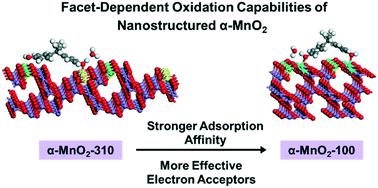当前位置:
X-MOL 学术
›
Environ. Sci.: Nano
›
论文详情
Our official English website, www.x-mol.net, welcomes your
feedback! (Note: you will need to create a separate account there.)
Nanostructured manganese oxides exhibit facet-dependent oxidation capabilities
Environmental Science: Nano ( IF 5.8 ) Pub Date : 2020-11-03 , DOI: 10.1039/d0en00958j Di Fu 1, 2, 3, 4, 5 , Lin Duan 1, 2, 3, 4, 5 , Chuanjia Jiang 1, 2, 3, 4, 5 , Tong Zhang 1, 2, 3, 4, 5 , Wei Chen 1, 2, 3, 4, 5
Environmental Science: Nano ( IF 5.8 ) Pub Date : 2020-11-03 , DOI: 10.1039/d0en00958j Di Fu 1, 2, 3, 4, 5 , Lin Duan 1, 2, 3, 4, 5 , Chuanjia Jiang 1, 2, 3, 4, 5 , Tong Zhang 1, 2, 3, 4, 5 , Wei Chen 1, 2, 3, 4, 5
Affiliation

|
Applying nanostructured manganese oxides (nano-MnOx) in contaminated agricultural lands offers the coupled benefits of oxidizing a range of environmental contaminants while simultaneously releasing micronutrients (i.e., dissolved Mn2+) that are vital for crop growth. However, little is known about how the key nanocrystal properties affect the oxidation capabilities of nano-MnOx. Here, we show that an α-MnO2 nanostructure with predominantly exposed {100} facets (referred to as α-MnO2-100) exhibits greater oxidation capability for bisphenol A (BPA, a model pollutant commonly found in agricultural lands) than an α-MnO2 nanostructure with predominantly exposed {310} facets (α-MnO2-310), while consistently releasing a greater amount of Mn2+. Fitting the reaction kinetics data using a retarded rate model shows that α-MnO2-100 possesses more reactive sites with higher reactivity. Density functional theory (DFT) calculations show that the {100} facet possesses a higher density of binding sites and the complexation of BPA molecules on the facet is thermodynamically more favorable, mainly due to its specific surface topography. Moreover, ligand-promoted Mn(III) release experiments and X-ray photoelectron spectroscopy analysis verify that α-MnO2-100 contains a greater abundance of surface Mn(III), a more effective electron acceptor than Mn(IV). The findings suggest that facet engineering can be exploited to improve the performance of nano-MnOx for sustainable agricultural applications.
中文翻译:

纳米结构的锰氧化物表现出与面有关的氧化能力
在受污染的农业土地上使用纳米结构的锰氧化物(nano-MnO x)具有氧化多种环境污染物,同时释放对作物生长至关重要的微量元素(即溶解的Mn 2+)的双重好处。然而,关于关键的纳米晶体性质如何影响纳米MnO x的氧化能力的知之甚少。在这里,我们表明,α-MnO的2纳米结构具有主要露出{100}面(被称为α-MnO的2 -100)比表现出更大氧化能力为双酚A(BPA,在农田中常见的模型污染物) α-MnO的2纳米结构具有主要露出{310}面(α-MnO的2 -310),而一致地释放的Mn量更大2+。拟合使用延迟率模型表明,α-MnO的反应动力学数据2 -100具有与较高反应性以上反应性部位。密度泛函理论(DFT)计算表明,{100}刻面具有较高的结合位点密度,并且BPA分子在刻面上的复合在热力学上更有利,这主要是由于其特定的表面形貌。此外,配位体促进的锰(III)释放实验和X射线光电子能谱分析验证α-MnO的2 -100包含表面的Mn的较大的丰度(III),比Mn(IV)更有效的电子受体。研究结果表明,可以利用刻面工程技术来改善纳米MnO x在可持续农业应用中的性能。
更新日期:2020-11-19
中文翻译:

纳米结构的锰氧化物表现出与面有关的氧化能力
在受污染的农业土地上使用纳米结构的锰氧化物(nano-MnO x)具有氧化多种环境污染物,同时释放对作物生长至关重要的微量元素(即溶解的Mn 2+)的双重好处。然而,关于关键的纳米晶体性质如何影响纳米MnO x的氧化能力的知之甚少。在这里,我们表明,α-MnO的2纳米结构具有主要露出{100}面(被称为α-MnO的2 -100)比表现出更大氧化能力为双酚A(BPA,在农田中常见的模型污染物) α-MnO的2纳米结构具有主要露出{310}面(α-MnO的2 -310),而一致地释放的Mn量更大2+。拟合使用延迟率模型表明,α-MnO的反应动力学数据2 -100具有与较高反应性以上反应性部位。密度泛函理论(DFT)计算表明,{100}刻面具有较高的结合位点密度,并且BPA分子在刻面上的复合在热力学上更有利,这主要是由于其特定的表面形貌。此外,配位体促进的锰(III)释放实验和X射线光电子能谱分析验证α-MnO的2 -100包含表面的Mn的较大的丰度(III),比Mn(IV)更有效的电子受体。研究结果表明,可以利用刻面工程技术来改善纳米MnO x在可持续农业应用中的性能。











































 京公网安备 11010802027423号
京公网安备 11010802027423号